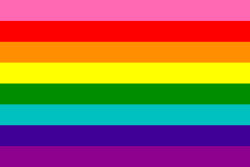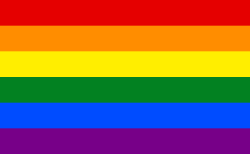Flags of the 2010s
The first known flag design made specifically for gay men was published online on October 9, 2018, on VK, a Russian website. [3] It was designed by Valentin Belyaev in the mid-2010s or earlier to combat gayphobia, and it was based on the lesbian flag. [4] It symbolizes the attraction of men to each other and the diversity of the gay community itself. [5] It is sometimes known as the Uranian flag. [6]
The first gay man flag design to be published online was designed by Mod Hermy of the Pride-Flags account on DeviantArt. [7] It was first posted on Tumblr on August 24, 2016, and was based on the pink lesbian flag. [8] [5]
In March 2017, Gilbert Baker created a nine-stripe version of his original 1977 flag, featuring lavender, pink, turquoise, and indigo stripes alongside red, orange, yellow, green, and purple. According to Baker, the lavender stripe symbolizes diversity. [9]
Another flag design for gay men, featuring green, teal, white, blue, and purple stripes, was designed by Tumblr user gayflagblog, a disabled trans man. [5] [10] [11] [12] [13] [14] [15] Two versions, with seven and five stripes respectively, were released on July 10, 2019. [16] [17] The colors from turquoise to green represent community, healing and joy; the white stripe in the middle is an iteration of part of Monica Helms' trans flag design and includes people who are transgender, intersex, gender non-conforming, or non-binary; and the colors blue through purple represent pure love, strength, and diversity. [18] [19] [20] This design is sometimes known as the Vincian flag, [4] [21] and referred to as the “ocean gay flag” by the flag designer and some users. [22]
- Flags for male homosexuality
Rainbow flag overlaid with a double black Mars symbol
Gilbert Baker's 2017 flag, nine stripes
Flag of seven blue, white and blue stripes
Uranist flag with double Mars symbol
Proposed flag, with shades of teal, pastel white, and blue.
Seven-stripe flag with green, teal, white, blue, and purple
[23] Five-stripe flag by gayflagblog, iterated from the seven-stripe flag
[24]
This page is based on this
Wikipedia article Text is available under the
CC BY-SA 4.0 license; additional terms may apply.
Images, videos and audio are available under their respective licenses.











